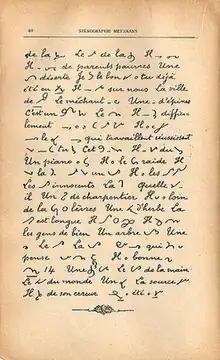Jules Meysmans | |
|---|---|
| Born | 14 May 1870 Jodoigne, Belgium |
| Died | 1943 (aged 72–73) |
| Nationality | Belgian |
| Occupation(s) | Stenographist, linguist |
| Known for | Creator of the word Interlinguistics |
Jules Meysmans (1870-1943) was a Belgian stenographer and linguist, who coined the term "interlinguistics". Meysman invented his own shorthand system, one of several adaptations he made of existing systems. Founder of an institute for stenography, he was active in the international auxiliary language movement, supporting various projects throughout his life, including Volapük, Esperanto, Idiom Neutral, and Occidental.
Career

Meysmans was born on 15 May 1870 to Pierre-Charles Meysmans, a cadastre surveyor; Pierre-Charles' occupation lead the family to move often. Léon Meysmans, who would later become a socialist politician, was his younger brother. After studying at a Catholic school in Tienen, Meysman received a teaching licence in Ghent. In 1890, he received his Doctor of Philosophy degree in humanistic studies[1] from the University of Ghent. The same year, he invented the "Meysmans" method of shorthand,[1] which was based on the Aimé Paris system – a notice in the 1922 Communal Notices of Brussels lists the "Aimé-Paris-Meysmans" system as being capable for the transcription of French, Flemish, English, and German.[2] Meysman's system acheived some success, being used by the Archdiocese of Kinshasa to train stenographers.[3] In 1897, he adapted Karl Friedrich Scheithauer's shorthand system, although he later stopped teaching this system.[4] Meysmans was the founder of the National Institute of Stenography and Dactylography (French: Institut National de Sténographie et de Dactylographie) in Brussels, and held courses for teaching shorthand in several cities in Belgium.[5]
Interlinguistics
Meysmans was involved in the international language movement during the Belle Époque. Originally, he was a member of the Volapük movement, before joining Esperanto in 1890 - he taught courses about the language in Ghent and Brussels.[1] In 1907, he became the leader of the Groupe de la Langue Internationale, a Brussels based group[5] which supported Idiom Neutral, a more niche international language created in 1902 by Waldemar Rosenberger.[1] In 1909, he created a reformed version of Idiom Neutral, titled Idiom Neutral Modifiket.[6] A founding figure of the Neo-Romanticist school of language creation,[7] Meysmans was a supporter Latin-based constructed languages, praising them in his contributions to Peano's journal Discussiones, which existed to support the Academia pro Interlingua - in 1913, Meysmans was vice-director of the organisation.[8] A Romance-based constructed language, which he called Interlatino, was published in 1912.[1] Eventually, he came to support Edgar de Wahl's Occidental, joining the Occidental-Academie's Explorative Committee for the International Auxiliary Language (Comite Explorativ del Lingue International Auxiliari) in 1929.[9]
Meysmans coined the term Interlinguistics as "interlinguistique" in 1911, in an article entitled A New Science (Une science nouvelle). This was published the monthly periodicalLingua Internationale, which Meysmans was chief editor of.[1] After its creation, the term was used primarily among Idists and Occidentalists[10] until 1931, when Danish linguist Otto Jespersen popularised it during a speech at the Second International Conference on Linguistics.[11] Meysmans originally defined the term as encompassing both the study of constructed international languages, but also that of natural languages as a form of trans-linguistic communication (language contact).[12] He also argued that constructed auxiliary languages could only become objects of study within the wider study of natural interlanguages, and that the use of auxilliary languages for international communication would be bounded by the same constraints as natural ones.[13]
References
- 1 2 3 4 5 6 Gobbo, Frederico (2023-10-20). "Ses difinoj serĉantaj fakon" [Six definition of new subjects]. Beletra Almanako 46 (BA46 - Literaturo en Esperanto) (in Esperanto). Mondial. p. 102. ISBN 978-1-59569-450-8.
- ↑ Ville de Bruxelles (1922). Bulletin Communal (PDF) (in French). Brussels. p. 156.
{{cite book}}: CS1 maint: location missing publisher (link) - ↑ "Actualites - Archdiocese de Kinshasa". Archdiocese of Kinshasa. Archived from the original on 20 October 2017.
- ↑ Navarre, Albert (1909). Histoire générale de la sténographie et de l'écriture à travers les âges (in French). Institut sténographique de France. p. 642.
- 1 2 "Biografio de Jules Meysmans" [Biography of Jules Meysmans] (PDF). Informilo por Interlingvistoj. February 2015. pp. 14–15. ISSN 1385-2191. Retrieved 2023-11-20.
- ↑ Libert, Alan Reed (2018-06-25), "Artificial Languages", Oxford Research Encyclopedia of Linguistics, doi:10.1093/acrefore/9780199384655.001.0001/acrefore-9780199384655-e-11?rskey=gwwfus&result=92, ISBN 978-0-19-938465-5, retrieved 2023-11-12
- ↑ Bernasconi, Edo (1977). "Neo-Romanticism in Language Planning". Esperanto aŭ interlingua? Faktoj kaj teorioj kontraŭ mitoj kaj antaŭjuĝoj (in Esperanto). Kultura Centro Esperantista.
- ↑ Peano, Giuseppe (1913-01-17). – via Wikisource.
- ↑ Berger, Ric (February 1929). "Cronica" [Annals]. Cosmoglotta. p. 36.
- ↑ Fiedler, Sabine; Haitao, Liu (2001). Studien zur Interlinguistik (in Esperanto). Kava-Pech. ISBN 978-80-85853-53-7.
- ↑ Boers, Frank; Darquennes, Jeroen; Kerremans, Koen (2009-10-02). Multilingualism and Applied Comparative Linguistics (Volume II). Cambridge Scholars Publishing. p. 25. ISBN 978-1-4438-1489-8.
- ↑ Halle-Wittenberg, Martin-Luther-Universität (1991). Wissenschaftliche Zeitschrift: gesellschafts- und sprachwissenschaftliche Reihe (in German). Martin-Luther-Universität Halle-Wittenberg.
- ↑ Schubert, Klaus (2011-06-01). Interlinguistics: Aspects of the Science of Planned Languages. Walter de Gruyter. p. 91. ISBN 978-3-11-088611-5.
External links
- Scanned version of the 1911-1912 publications of Lingua Internationale from Austrian Newspapers Online
